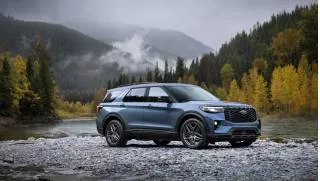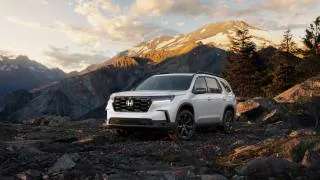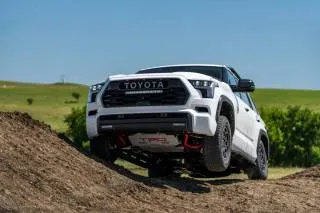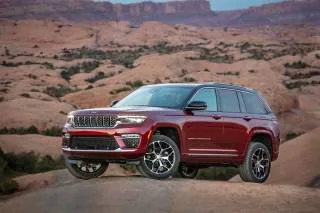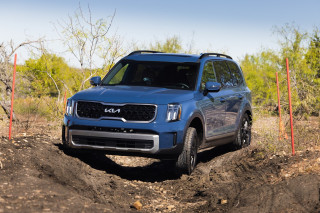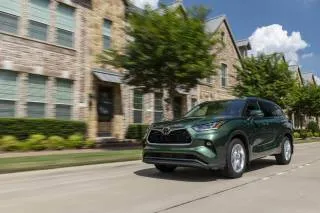Likes
- Body style options
- Two available hybrid powertrains
- Family-friendly practicality
- Spacious third row in Grand Highlander
- Up to 35 mpg
Dislikes
- Standard Highlander’s small third row
- Subpar efficiency in Hybrid Max
- Gets expensive
- Grand Highlander’s excessive size
Buying tip
features & specs
The Highlander lineup offers family-friendly space and budget-friendly hybrids.
What kind of car is the 2025 Toyota Highlander? What does it compare to?
The Highlander and Grand Highlander are three-row SUVs. The Grand version, introduced in 2024, rides on a wheelbase several inches longer for more passenger and cargo space, resulting in utility similar to Toyota’s Sienna minivan. With three powertrains in the Highlander lineup, shoppers can balance needs between power and efficiency. Competitors include the Ford Explorer, Honda Pilot, Kia Telluride, and Jeep Grand Cherokee L.
Is the 2025 Toyota Highlander a good SUV?
Yes. The Highlander Hybrid and Grand Highlander Hybrid, in particular, are among the most efficient three-row SUVs on the market, and only the Toyota Sienna and plug-in Chrysler Pacifica Hybrid minivans are better. The 2025 Highlander lineup scores a 7.0 TCC Rating on our 10-point scale. (Read more about how we rate cars.)
What’s new for the 2025 Toyota Highlander?
There are a handful of changes to the Highlander lineup for 2025, but the 2025 Grand Highlander changes haven’t been announced yet. Toyota makes all-wheel drive standard on all Highlander Hybrid models, discontinues the Hybrid LE trims, discontinues the front-wheel-drive versions of the non-hybrid XSE and Platinum trims, and updates the exterior and interior color palettes across the range. There’s also a new 25th Anniversary Edition package, exclusive to the Hybrid Limited model, featuring unique exterior body elements, exterior badging, and headrest embossing.
The Highlander and Grand Highlander share no sheetmetal, but they do have a similar basic look. The Highlander is more rounded off and squatter, while the Grand Highlander sits more upright. We think the Grand is a little better integrated.
Both have trapezoidal grilles flanked by slit-style headlights, but the Grand’s face has a larger maw and a more vertical look. Along the sides, the Highlander sports a flowing, curved character line that rises toward the rear, while the Grand goes with a cleaner, more slab-sided look. The window line is the same theme for both, with a kick up at the rear that meets an angle that reflects the slanted rear window.
Inside, the two SUVs are more similar, with two versions of a tiered dashboard, and wide, useful center consoles. The Highlander comes standard with an 8.0-inch touchscreen and is available with a 12.3-inch screen, while the Grand gets the larger screen standard. Available bronze trim adds flair to the dash and center console in both.
Both versions of the Highlander come standard with eight-passenger seating, though most configurations seat seven, with captain’s chairs replacing the second-row bench. The Grand Highlander has a larger cabin thanks to an additional 3.9 inches of wheelbase, a 6.5-inch longer body, and taller and wider dimensions as well. The cabin makes great use of the space, with plenty of storage and roughly six more inches of legroom for rearmost riders. Still, the Highlander has lots of space in its own right.
Toyota offers the Highlander with a choice of powertrains. The base Highlander comes with a 2.4-liter turbo-4 rated for 265 hp and 310 lb-ft of torque. That engine provides adequate thrust and works well with its 8-speed automatic transmission. It’s available in front- and all-wheel drive. The Highlander Hybrid is exclusively all-wheel drive for 2025. It uses a 2.5-liter inline-4 and three motors for a combined output of 243 hp.
The Grand Highlander is available with a third powertrain, the Hybrid Max, shared with the Toyota Crown. It combines the 2.4-liter turbo-4 with a front and a rear motor, yielding all-wheel drive as standard. This version hauls the hefty Grand Highlander from 0-60 mph in 6.3 seconds, though it falls short of the Highlander Hybrid in terms of fuel economy.
The 2025 Toyota Highlander lineup includes standard automatic emergency braking with pedestrian detection, adaptive cruise control, active lane control, and automatic high beams. Blind-spot monitors are standard above the entry-level L, and buyers can get a surround-view camera system and a low-speed driver-assist system for clogged freeways.
Crash-test results are mixed. The standard Toyota Highlander typically earned good ratings from the IIHS and the NHTSA in 2024, though the Grand Highlander fell short in its debut year.
How much does the 2025 Toyota Highlander cost?
The base Toyota Highlander L starts at about $38,000, including a $1,335 destination fee, and features an 8.0-inch infotainment touchscreen with Apple CarPlay and Android Auto. That doesn’t include all-wheel drive for $1,600, or the hybrid powertrain for another $1,600. For a comparison between two well-equipped versions, look at the Grand Highlander in XLE trim, for about $45,000, or the Highlander XLE, for about $44,000. We’d spend the extra grand for the Grand.
Budget about $60,000 for a top-end Grand Highlander Hybrid Max. It’ll deliver a Lexus-like experience, but it’s no bargain.
The 2025 Toyota Highlander comes in L, LE, XLE, XSE, Limited, and Platinum trims; the Highlander Hybrid skips over the L and LE models. The Grand Highlander trim lineup was not available at press time, though the 2024 model comes in XLE, Limited, and Platinum trims.
Pricing will be confirmed closer to both models’ on-sale date in late 2024.
Where is the 2025 Toyota Highlander made?
Toyota builds both versions of the Highlander in Indiana.
2025 Toyota Highlander Styling
The 2025 Highlander and Grand Highlander are related more by name than by appearance, to the Grand’s advantage.
Is the Toyota Highlander a good-looking SUV?
Some versions of the Highlander are more attractive than others. While the regular Highlander could be mistaken for its stablemate, the Toyota Sienna minivan, from a distance, the Grand Highlander adds plenty of visual flair. It’s 2.0 inches taller, 2.3 inches wider, and 6.5 inches longer than the regular Highlander, though it has a smoother profile framed by boxy fenders, with a soothing front fascia. That’s good for a point, and we award another for both models’ clean, simple cabin. It’s a 7.
With its geometric grille, LED lighting with DRLs, and chrome beltline, the Grand Highlander could easily be a Lexus. The regular Highlander has similar proportions, but the Grand wears them better. It has smoother lines that result in a more elegant profile, punctuated by boxy fenders that flow into sculpted rocker panels. The beltline carves out big rear windows for an airier greenhouse, and Hybrid Max versions wear dark 20-inch wheels and dual exhaust outlets.
Inside, the Highlander and Grand Highlander’s relationship is more apparent, thanks largely to Toyota’s clever storage solutions, like a tiered dashboard with a shelf for smartphones. The Grand version goes a few steps further, with an open bridge console, a deep cubby in the center console that can be accessed even if the driver is using the armrest, and a compact electronic gear shifter.
Both models get attractive bronze highlights on the console and dash, though the Grand Highlander has a larger 12.3-inch touchscreen that is optional in the Highlander. The screen is better integrated in the Grand Highlander as it rises symmetrically from the dash, while the Highlander version sits in an asymmetrical flourish of odd forked design. However, the Highlander’s wireless charging pad is better located under the touchscreen and vents, while in the Grand version it’s shoved in where the stack and console meet.
2025 Toyota Highlander Performance
While most Highlander versions simply get the job done, the Grand Highlander Hybrid Max is genuinely enjoyable.
In addition to choosing between the two body styles, Highlander shoppers have a choice of three powertrains. The Highlander and Grand Highlander both come standard with a 2.4-liter turbo-4. The Highlander Hybrid gets a familiar, efficient powertrain, and the Grand Highlander Hybrid Max is the crown of the bunch, with good power and improved handling. We award a point for ride quality, for a 6.
Is the Toyota Highlander 4WD?
It can be. The Highlander and the regular Grand Highlander have standard front-wheel drive with available all-wheel drive, and the Highlander Hybrid and Grand Highlander Hybrid Max have standard AWD.
The systems are different according to the model. Base gas-only versions have a basic on-demand system, while the Limited and Platinum gas-only versions are enabled by a rear motor and feature torque vectoring for better traction and handling.
How fast is the Toyota Highlander?
Not particularly quick, except for the Grand Highlander Hybrid Max. Both Highlander models feature a 2.4-liter turbo-4 in base form, which also powers the Toyota Tacoma. Here, it pairs with an 8-speed automatic transmission and is rated for 265 hp and 310 lb-ft of torque. It’s loud and the shifts are sometimes coarse, particularly when Sport mode is selected and especially compared to the hybrid powertrains, though the torque is arguably worth it. In the heavier Grand Highlander, this engine is good for a 7.5-second run from 0-60 mph.
The Hybrid is on the sluggish side because it prioritizes efficiency. The Hybrid’s powertrain combines a 2.5-liter inline-4 with two motors on the front axle, one at the rear, and a battery pack. That’s good for a combined EPA rating of 35 mpg, and it’s capable of all-electric driving at steady low speeds of around 15 mph in Normal, Eco, and Sport modes.
Gas AWD and Grand Highlander Hybrid Max versions are capable of towing up to 5,000 pounds, and gain Rock & Dirt, Mud & Sand, and Snow modes.
Grand Highlander Hybrid Max impressions
The Hybrid Max option is available only with the Grand Highlander. It supplements the turbo-4 with a pair of motors, one on each axle, and uses a 6-speed automatic transmission. This powertrain, rated for 362 hp and 400 lb-ft, is shared with the Toyota Crown, and the hybrid system has been adapted for the Lexus RX 500h and the Toyota Tundra.
Thanks to this system, the Toyota Grand Highlander has oomph that sets it apart not only from the rest of the Highlander lineup, but from most of its rivals. It can zip from 0-60 mph in just 6.3 seconds, while Sport mode lends extra personality. The full-time AWD system can shift torque from a 70:30 front-to-rear to a 20:80 split, for an interesting shift in the driving dynamics, while the engine provides V-6-like notes.
An independent suspension smooths out bumpy and bounding roads, and though the Grand Highlander’s size makes it a bit ponderous, body lean is well managed. Skip the optional 20-inch wheels if the usually smooth ride quality is a concern. While the steering initially feels loose, it responds well in turns.
2025 Toyota Highlander Comfort & Quality
Stick with the Grand Highlander for the most cabin space.
The Toyota Grand Highlander’s 116.1-inch wheelbase adds 3.9 inches to the original Highlander, which makes the cabin much more spacious and comfortable. Both versions of the 2025 Highlander rate a 9, with points awarded for the comfortable front and rear seats, generous cargo capacity, and ability to seat at least five adults comfortably.
From trims XLE on up, the Highlander and Grand Highlander feature heated and power-adjustable front seats, 13 cupholders, and seven USB ports. Depending on trim, seven- and eight-seat configurations are available. The seats are spacious and comfortable, but the latches to slide or fold them are more complicated than rivals’ push-button releases.
The Highlander offers easy ingress and egress thanks to wide doors and a step about four inches below the seat bottoms. Between the two models, there’s just a 1.5-inch difference in second-row legroom, but the Grand Highlander’s extra space shines in the third row. Even though those seats sit on a raised floor, there’s still plenty of space, with an above-average 33.5 inches of legroom and plenty of headroom. By comparison, the base Highlander’s 27.7 inches of rear-row legroom is quite restrictive.
The Grand Highlander’s cargo space is another notable advantage. The larger model offers a 20.6-cubic-foot cargo area behind the third row compared to the Highlander’s 16.0 cubes. A pull strap easily collapses the third row, opening up 57.9 and 48.4 cubic feet for the Grand Highlander and Highlander, respectively. That extends to a very useful 84.3 and 97.5 cubes, respectively, with the rear two rows folded down.
2025 Toyota Highlander Safety
The Toyota Highlander lineup gets a lot of standard driver-assistance features.
How safe is the Toyota Highlander?
In 2024, the Toyota Highlander fared well in NHTSA and IIHS testing, earning five stars from the former and a Top Safety Pick rating from the latter. Add points for standard safety features and driver-assist tech options, and the Highlander gets a 9 here. The rating could change when 2025 crash-test results come out.
Rated separately, the Grand Highlander would score a point lower, since it didn’t earn the IIHS Top Safety Pick rating in its 2024 testing.
The Highlander comes standard with automatic emergency braking with cyclist and pedestrian detection, active lane control, adaptive cruise control, and a driver-alert monitor.
The XLE trim and above add blind-spot monitors. Other options include a head-up display, a surround-view camera system, and parking sensors. The Grand Highlander is available with a subscription-based traffic jam assist feature that enables limited hands-free operation at speeds of less than 25 mph. For the 2024 model, the subscription price is $15 per month.
2025 Toyota Highlander Features
Toyota outfits the 2025 Highlander with plenty of equipment.
The Toyota Highlander earns points for its generous standard features, good infotainment, and overall value, racking up an 8. Its options are also impressive, including cooled seats in the second row and facial recognition for driver settings.
The Highlander lineup features average warranty coverage, 3-years/36,000-miles, plus included scheduled maintenance for 2 years/25,000 miles.
The base Highlander L and base Hybrid, at about $38,000 and $42,000, respectively, include an infotainment system with an 8.0-inch touchscreen, Android Auto and Apple CarPlay, cloth upholstery, a power-adjustable driver seat, and 18-inch alloy wheels. Budget another $1,600 for all-wheel drive.
Which Toyota Highlander should I buy?
Budget about $50,000 for a Grand Highlander Hybrid in XLE trim. It offers great space and great fuel economy, plus such standard features as a power tailgate, synthetic leather upholstery, a 12.3-inch touchscreen, and wireless phone charging.
How much is a fully loaded Toyota Highlander?
The Grand Highlander Hybrid Max Platinum trim should also cost about $60,000. That brings leather and synthetic suede upholstery, a head-up display, 11-speaker JBL audio, a rear camera mirror, heated and cooled second-row outboard seats, a panoramic sunroof, a surround-view camera system, traffic jam assist, and 20-inch wheels.
2025 Toyota Highlander Fuel Economy
The Highlander Hybrid is the mileage champ of the segment, with a rating of 35 mpg combined.
Is the Toyota Highlander good on gas?
It is, particularly in hybrid form. Fuel economy ratings aren’t available for 2025, but they should be unchanged from 2024. The standard 2024 Highlander’s turbo-4 was estimated for 22 mpg city, 29 highway, 25 combined in front-drive configuration and dropped to 21/28/24 mpg with all-wheel drive. The Limited and Platinum shed at least 1 highway mpg. That’s good for a 3, though this rating has room for improvement if hybrid sales outpace base sales.
The 2024 Highlander Hybrid was EPA-rated at up to 35/35/35 mpg, though the now-discontinued front-drive Hybrid got 36 mpg combined.
The 2024 Grand Highlander Hybrid was rated as high as 37/34/36 mpg with front-drive. That fell to 36/32/34 mpg with all-wheel drive. The Max was rated as 26/27/27 mpg, while the standard turbo-4 was rated as high as 21/28/24 mpg with front-wheel drive and 21/27/23 mpg with all-wheel drive.






































































































